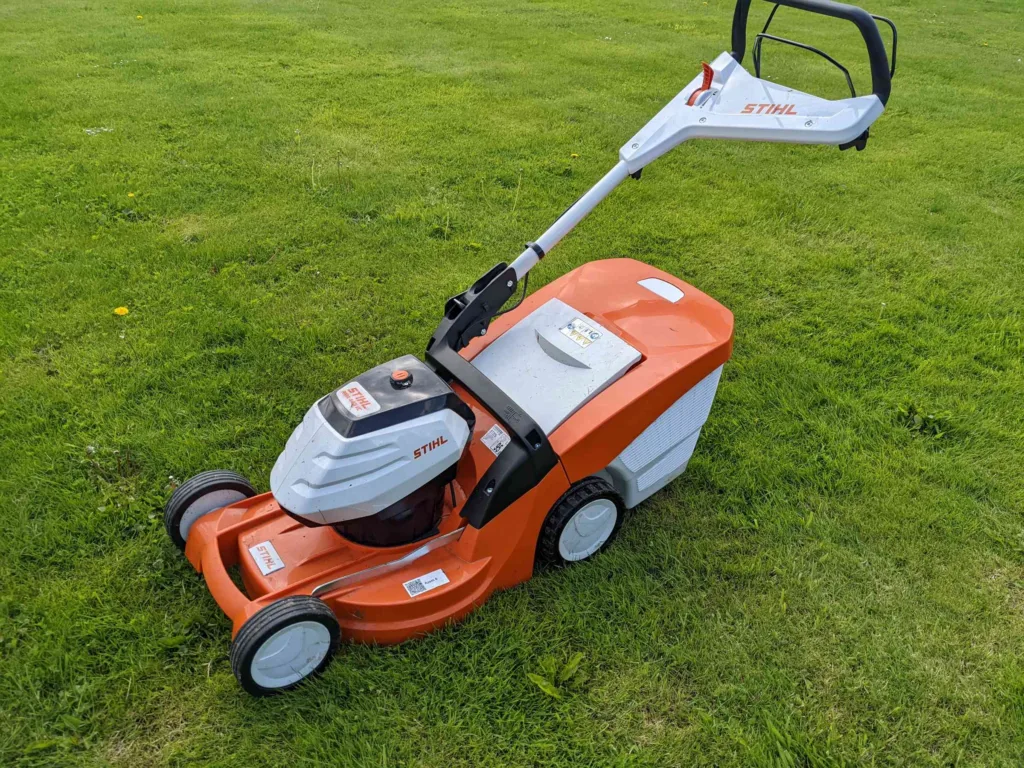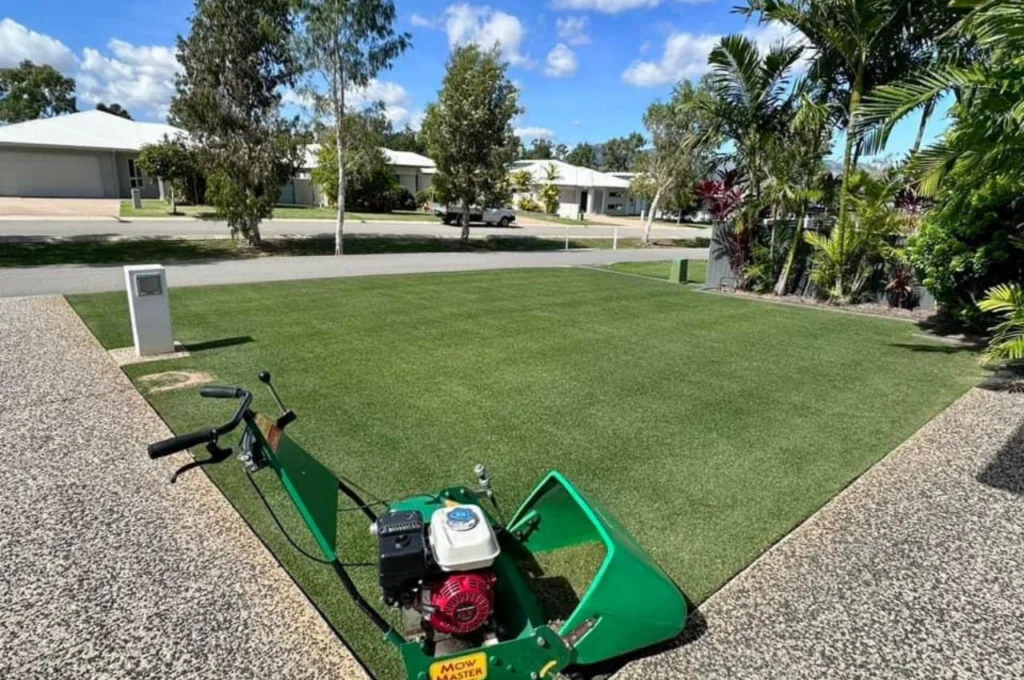Self-propelled lawn mowers take away the effort of mowing a large lawn, but how do you know if a self-propelled lawn mower is worth it for you?
In this guide, we’ve discussed the main pros and cons of self-propelled lawn mowers, so you can decide whether this mower type is right for your situation.
✅Key Takeaways:
The key advantages of self-propelled lawn mowers are that they’re easier to use than regular push mowers, they help you mow your lawn more quickly and efficiently, and they require less effort, simplifying your mowing experience.
The disadvantages of self-propelled lawn mowers are that they’re more expensive than conventional mowers, some only have a set speed that might be too fast for you, and the self-propulsion system makes them heavier.
Table of Contents
👍 Self-Propelled Lawn Mower Pros
Here are some of the key advantages of self-propelled lawn mowers compared to conventional mowers without a drive system.
🏋🏼♂️ They’re Easier To Use
Self-propelled mowers are easier to operate compared to push mowers because they move forwards on their own.
You only need to walk behind the mower and guide it in the right direction. Mowing the lawn isn’t particularly complex anyway, and using a self-propelled mower makes the chore even easier.
💪 They Require Less Physical Effort
Another big benefit of self-propelled lawn mowers is that they require virtually no physical effort from you.
Using a self-propelled mower is less tiring, especially if you’re mowing a larger lawn or uneven terrain. If you struggle to push a heavy lawn mower, a mower with self-propulsion is the answer.
🏁 They’re Quicker And More Efficient
Self-propelled mowers typically have more powerful engines, which drive the mower forward at a brisk walking pace.
You don’t have to struggle with a self-propelled mower on longer, thicker grass or hills, meaning the mower can maintain the same efficient cutting speed regardless of your situation. That means you can get the job done faster and admire your work with a nice cup of tea in no time – bliss!
🏔 They’re Ideal For Sloped Or Hilly Lawns
A self-propelled lawnmower is the makes-sense solution if you have a sloped or hilly lawn. The mower’s self-propulsion system prevents you from putting your back out manually pushing the machine up hills and inclines.
The gravitational pull when mowing on slopes is no match for a self-propelled mower. Not only is hill mowing less strenuous with self-propelled mowers, but they also improve your safety by minimizing your risk of slips and falls on steep slopes.
🏍 They Offer Better Maneuverability
In some ways, self-propelled mowers are easier to manoeuvre than conventional manual push lawn mowers.
Because you only have to focus on steering, not pushing, a self-propelled lawnmower, you’ll find that you can guide the mower effortlessly in your desired direction while the engine powers the wheels.
Self-propelled mowers simplify the task of navigating around obstacles, tight corners, and borders, helping you to be more precise with the directions you take because you don’t have the additional challenge of pushing the mower.
🟢 They Produce A Smoother Cut
Self-propelled mowers also produce a smoother cut than conventional mowers because they enable you to mow less erratically.
Imagine the process of mowing with a normal non-self-propelled mower. You’ll likely yank the mower backwards and forwards as you struggle with its weight, resulting in a less uniform cut.
Self-propelled mowers give a cleaner cut because the mower moves at the same forward speed regardless of the terrain type or incline.

👎 Self-Propelled Lawn Mower Cons
By now, you probably think you’ve read enough to make up your mind: a self-propelled mower is for you. But don’t spend your money until you’ve read up on the downsides of this mower type.
💰 They’re More Expensive Than Conventional Mowers
Because self-propelled mowers offer the additional convenience of self-propulsion, they’re more expensive than conventional mowers.
Expect to pay around 10-20% more for a self-propelled mower compared to a conventional petrol-powered push lawn mower. So, if a petrol mower costs £320, the same mower with self-propulsion may cost up to £364.
If your budget is tight and you want to go for a relatively low-cost lawn mower, a self-propelled lawnmower might not be right for you.
🏎 The Self-Propulsion Speed Might Be Too Fast
Most self-propelled mowers for domestic use have only a single walk-behind speed. We’ve read reviews for these mowers from countless people – especially older gardeners – who say the forward speed is just too fast for them to comfortably keep up.
For most active adults, the brisk walking speed of a self-propelled lawn mower should be fine. But your mower’s pre-set speed might be too fast, or even too slow, for you.
If it’s important for you to be able to control your self-propelled lawn mower’s speed, make sure to choose a mower with variable speed. Just be aware that the ability to adjust the forward speed will further increase the mower’s price.
⚖️ They’re Heavier Than Manual Push Mowers
Another disadvantage of self-propelled mowers compared to conventional push lawn mowers is that they’re around 5-10 kilograms heavier.
The extra weight of the self-propulsion system adds to what is already likely a heavy mower (most petrol mowers are larger than electric mowers and use heavy engines, making them heavier by default).
The good news is that you won’t have to take the weight of the mower during the actual mowing, but you might struggle to get a heavy mower in and out of storage – especially if you’re over the age of 60 or have mobility issues.
👮♂️ The Self-Propulsion Steals A Portion Of The Engine Power
A conventional push mower dedicates all of its engine power to the blades, ensuring that the mower’s cutting performance is as powerful as possible. A self-propelled lawn mower, on the other hand, diverts some of its engine power to the self-drive system, which means less power is assigned to the blades.
In a petrol mower, this is unlikely to affect the mower’s performance or the quality of the end result, especially since self-propelled lawn mowers usually have slightly larger engines to account for this split between engine power dedication.
However, some battery-powered self-propelled lawnmowers may struggle in certain scenarios, such as cutting long, thick grass while climbing a steep slope. Keep this in mind when deciding on the best self-propelled mower for you.
🤏 They’re Not Practical For Smaller Lawns
You might think that a self-propelled lawnmower is better than an equivalent push mower in all scenarios because it’s easier to use. But actually, walk-behind mowers are incredibly impractical on small lawns, and you’ll actually be doing yourself a disservice by buying this mower type for a small garden.
Self-propelled units are usually much bigger and wider than conventional mower models because they’re intended for efficiently cutting large spaces.
Using a wide, bulky mower on a small lawn means you’ll struggle more with maneuverability. You might not have enough space to turn the mower after every lap, the mower might be too big for getting into tight spots, and the self-propulsion function will probably be pretty pointless if there are less than 20 steps from one end of your lawn to the other.
📡 There’s An Extra Feature To Maintain And Repair
Finally, self-propelled mowers have an extra feature that other mowers don’t have: the self-drive system.
While self-propelled lawnmowers don’t have a reputation for breaking down, you know how it works: the more features a mower has, the more features there are to maintain and repair.
Self-propelled drive systems consist of a number of intricate components, and there’s always the potential for one of these to break or suffer wear, affecting your mowing experience.

💸 Are Self-Propelled Mowers Worth It?
Looking to buy a new lawn mower and wondering whether a self-propelled model is worth the cost? This depends on your personal preferences and situation.
If you have a large lawn (bigger than 500-750 m²) and you can stretch your budget to a mower with self-propulsion, go for it. You’ll appreciate that the mower takes a lot of the extra effort off your hands – all you have to do is walk behind it in a straight line and steer when necessary. In fact, we would advise only using a self-propelled mower on a big lawn because using a conventional push mower will exhaust you.
If you have a smaller lawn and your budget is on the lower end, you might decide that a self-propelled mower isn’t for you. Plus, we don’t recommend self-propelled lawn mowers for people looking for a lightweight mower that takes up minimal storage space and is easy to maintain (everything that a self-propelled mower isn’t).
Ready to start shopping for a petrol mower? You’ll find our reviews of the best self-propelled mowers currently available on Amazon in our best self-propelled lawn mowers guide.
